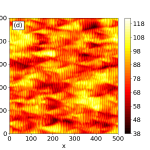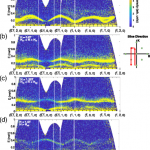
Nanoscale patterns produced by bombarding a surface with an ion beam
When an energetic ion strikes a solid surface, one or more atoms can be ejected from the solid. Bombarding a flat solid surface with a broad ion beam therefore results in erosion of the solid. Naively, one would expect that the solid surface would simply remain flat as it is eroded. Instead, a remarkable variety of self-assembled nanoscale patterns can form, including periodic height modulations or “ripples.” The spontaneous emergence of these patterns is not just fascinating, since in the future ion bombardment may prove to be an important tool in the fabrication of nanostructures.
Dispersion occurs if ripples of different wavelengths propagate over the surface with different velocities. In a new paper on the theory of ion-induced pattern formation [1], graduate student Kevin Loew and Prof. Mark Bradley have shown that dispersion leads to the formation of raised and depressed triangular regions traversed by ripples (see figure). These bear a strong resemblance to nanostructures that are commonly observed in experiments. Dispersion can also lead to the formation of highly ordered ripples. These would be more useful in applications than the defect-ridden ripples normally produced in experiments.
[1] K. M. Loew and R. M. Bradley, “The Effect of Dispersion on the Nanoscale Patterns Produced by Ion Sputtering,” Phys. Rev. E 100, 012801 (2019).

